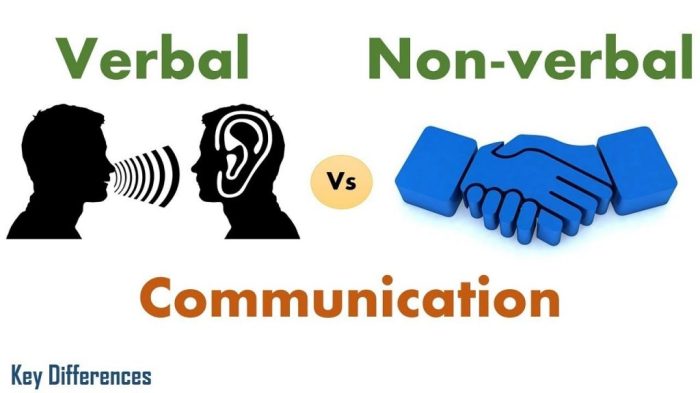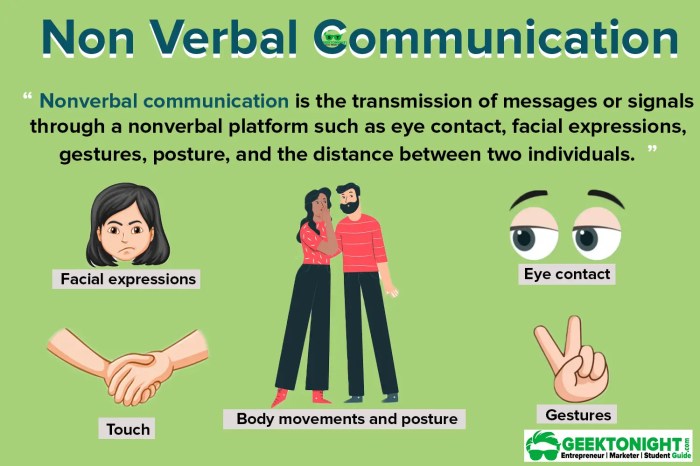In the realm of communication, nonverbal cues hold immense significance, conveying messages that transcend words. Yet, misconceptions abound, obscuring the true nature of this powerful form of expression. This exploration delves into which of the following statements about nonverbal communication is false, unveiling the truth amidst the myths.
Nonverbal communication encompasses a vast array of cues, from subtle facial expressions to expressive body language. These cues play a pivotal role in shaping our interactions, influencing perceptions, and fostering connections. However, misunderstandings and misinterpretations can arise when we fail to grasp the complexities of nonverbal communication.
Misconceptions about Nonverbal Communication

Nonverbal communication is a complex and often misunderstood aspect of human interaction. Despite its importance, there are several common misconceptions about nonverbal cues that can lead to misinterpretations and ineffective communication.
Reasons for Misconceptions, Which of the following statements about nonverbal communication is false
- Cultural Differences:Nonverbal cues can vary significantly across cultures, making it difficult to interpret them accurately outside of one’s own cultural context.
- Limited Awareness:Many people are simply not aware of the significance of nonverbal cues and their impact on communication.
- Stereotypes:Stereotypes and generalizations about nonverbal behavior can lead to inaccurate assumptions and misinterpretations.
Importance of Nonverbal Cues

Nonverbal cues play a crucial role in communication, conveying a wide range of emotions, intentions, and messages. They can:
- Enhance Communication:Nonverbal cues can complement and reinforce verbal messages, adding depth and nuance to communication.
- Provide Insight:Nonverbal cues can reveal hidden emotions, attitudes, and intentions that may not be expressed verbally.
li> Influence Relationships:Nonverbal cues can impact the development and maintenance of relationships by conveying trust, warmth, or hostility.
Cultural Variations
It is important to note that nonverbal cues can vary significantly across cultures. For example, in some cultures, direct eye contact is considered a sign of respect, while in others, it can be perceived as aggressive.
Types of Nonverbal Communication: Which Of The Following Statements About Nonverbal Communication Is False
| Type | Characteristics | Functions | Examples |
|---|---|---|---|
| Facial Expressions | Convey emotions, intentions, and attitudes | Express happiness, sadness, anger, surprise | |
| Gestures | Hand and body movements that convey meaning | Pointing, waving, shrugging | |
| Body Language | Posture, stance, and overall body position | Convey confidence, dominance, or submission | |
| Eye Contact | The direction and duration of eye contact | Establish connection, convey interest or disinterest | |
| Paralinguistics | Vocal cues that accompany speech | Tone, volume, pitch |
Nonverbal Communication in Specific Contexts

Nonverbal cues play a significant role in various communication contexts:
Business Settings
In business settings, nonverbal cues can convey professionalism, confidence, and trust. For example, maintaining eye contact and using appropriate gestures can indicate attentiveness and engagement.
Social Interactions
In social interactions, nonverbal cues can facilitate rapport, establish boundaries, and convey emotions. For example, smiling and nodding can indicate friendliness and warmth.
Educational Environments
In educational environments, nonverbal cues can enhance learning and facilitate communication between teachers and students. For example, gestures and facial expressions can emphasize key points and convey enthusiasm.
Developing Nonverbal Communication Skills

Improving nonverbal communication skills can significantly enhance communication effectiveness. Here are some tips:
- Observe Others:Pay attention to how others use nonverbal cues in different situations.
- Practice:Consciously practice using appropriate nonverbal cues in your own communication.
- Seek Feedback:Ask for feedback from trusted sources to identify areas for improvement.
Benefits
- Enhanced Communication:Improved nonverbal skills can lead to more effective and nuanced communication.
- Stronger Relationships:Nonverbal cues can help build rapport and strengthen relationships.
- Increased Confidence:Developing nonverbal communication skills can boost confidence and make you a more effective communicator.
Challenges
- Cultural Differences:Being aware of cultural variations in nonverbal cues is crucial to avoid misinterpretations.
- Personal Biases:Personal biases and assumptions can influence how we interpret nonverbal cues.
- Limited Control:Some nonverbal cues, such as facial expressions, can be difficult to control consciously.
Helpful Answers
Is nonverbal communication always reliable?
While nonverbal cues can provide valuable insights, it’s essential to recognize that they are not always infallible. Context, cultural differences, and individual variations can influence the interpretation of nonverbal behavior.
Can nonverbal communication be learned and improved?
Yes, with practice and self-awareness, individuals can enhance their nonverbal communication skills. Paying attention to one’s own cues and observing others can help develop a more effective and nuanced repertoire of nonverbal expressions.